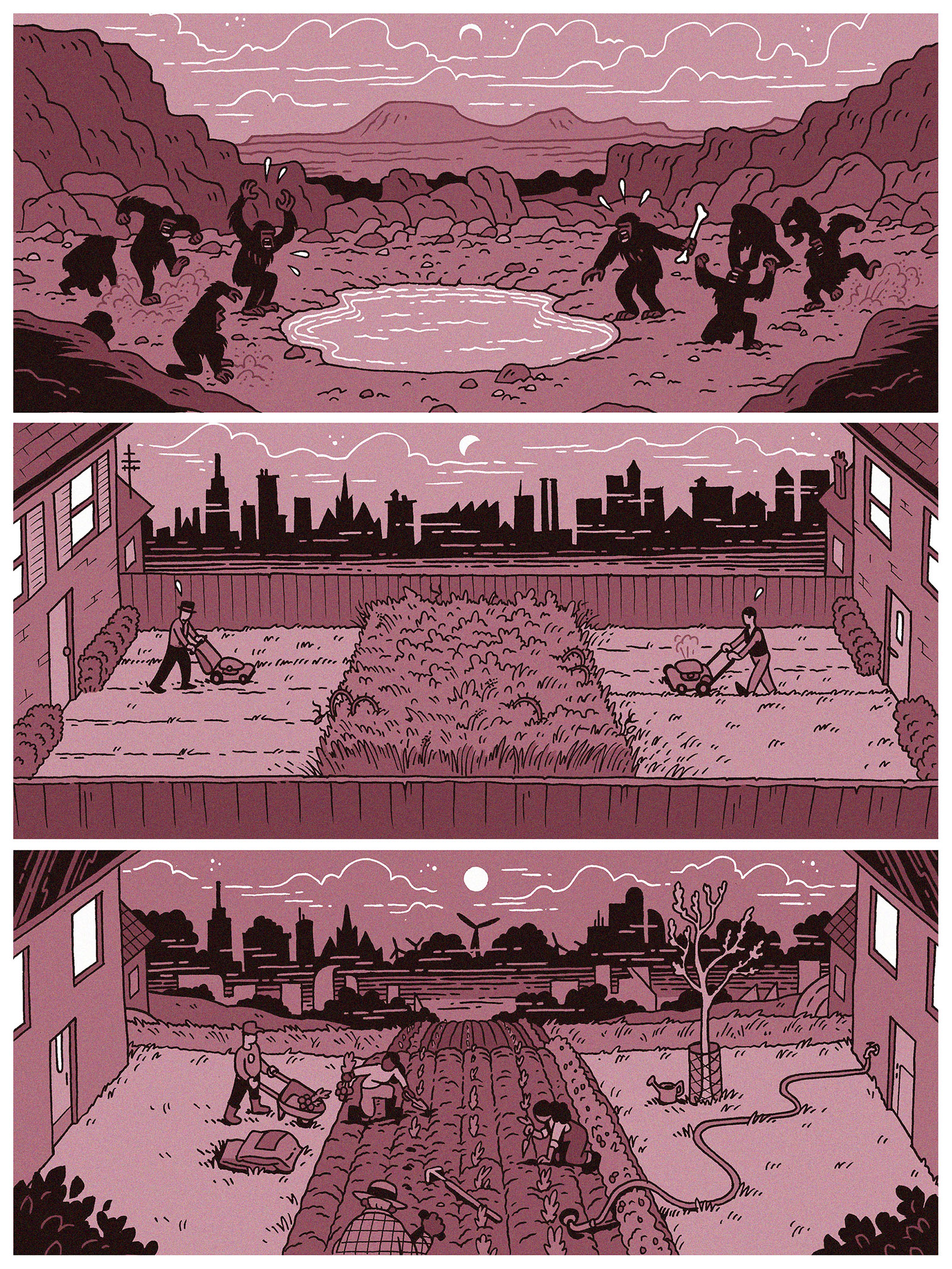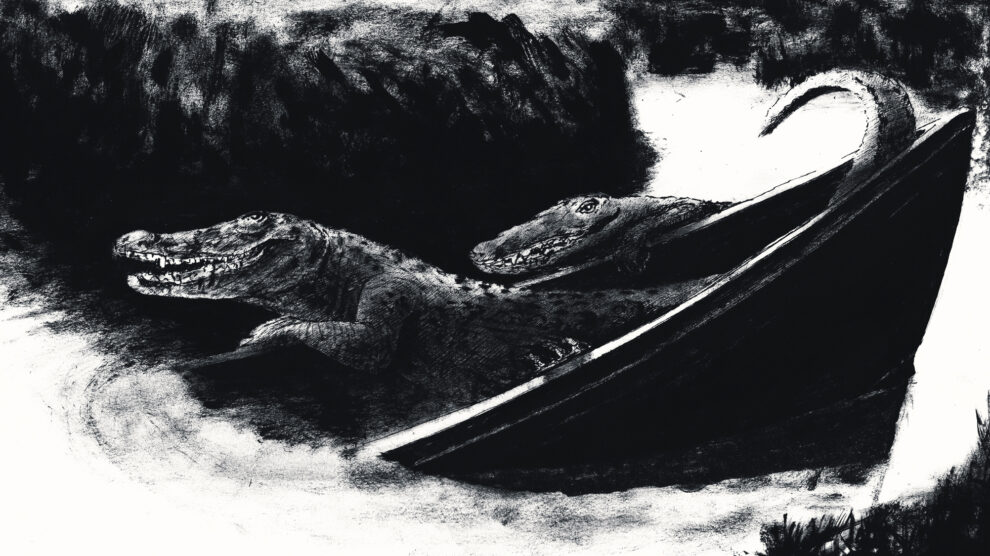Making Metaphors into Models
“The Tragedy of the Commons” and the Scientization of Competition and White Supremacy
By Tegan Morton
Volume 24, no. 3, Cooperation: Theory and Practice for the Commons

“The Tragedy of the Commons” by Garrett Hardin purports to advance a fundamental model in environmental and natural sciences, with explanatory power for the decline of natural resources due to overexploitation by humans driven by self-interest.1 According to this model, as individual farmers add more and more livestock to graze on a common pasture, the quality of the field inevitably declines. The farmers are thus continuously driven to maximize their own personal returns via increasing livestock, becoming caught in a prisoner’s dilemma of limited knowledge of others’ grazing patterns. While in competition with others, they are pulled toward violating proclaimed community values of moderation or cooperation.2 The article primarily rests on a thought experiment rather than on empirical evidence. Hardin presents this tragedy as deterministic and unavoidable: overexploitation of resources by individuals left to their own devices is inevitable. This in turn requires the intervention of the State to manage those presumed incapable of managing themselves.
Environmental historian Fabien Locher has exhaustively recounted Hardin’s intellectual and political trajectory and the “context in which he socialized as a biologist” to illuminate the theoretical challenges at the heart of Hardin’s metaphor.3 In natural science courses, in contrast to social science courses, Hardin is rarely presented with a critical lens; his model tends to be accepted as scientific fact.4 In one survey of natural science professors’ attitudes towards “The Tragedy of the Commons,” the need to continue teaching it was defended with the circular argument that the article is “still highly influential in ecological circles.”5 Efforts to separate the science from the scientist in teaching “The Tragedy of the Commons” have not been effective.
The Cold War, Game Theory, and Misanthropic Assumptions About Human Nature
For Hardin the intellectual work of science was a political medium, and his work is best understood in the context of his political beliefs and values. Hardin codifies metaphors of selfish individual actors and the supremacy of competition in biology into models justified by his philosophy. His tragedy is not just a model made metaphor, but instead a metaphor masquerading as a scientific model. As both an articulation of social Darwinism and an extension of the misanthropic assumptions of Homo oeconomicus inherent to mathematical game theory, the tragedy of the commons is often assumed to be self-evidently true.6 Furthermore, Hardin’s vision of a state that manages resources to the benefit of those presumed to be the fittest amounts to an ideological tautology wherein he aligns biology with neoliberal economics to legitimate his assumptions.
Fundamental to this alignment is the presumption that one-against-all competition is the immutable essence of human nature. Hardin’s prominence in ecology came from his theoretical articulation of the competitive exclusion principle, “the idea that competition between individuals, groups, and species was inherent in biological life,” one in which a “‘natural’ state of conflict was integral to human groups.”7 This inevitability of competition is central to Hardin’s understanding of biology and ecology, and from this competition all emergent patterns and relationships can be explained.
Hardin was hardly alone in visualizing competition between individuals as the fundamental condition of all organisms and systems. Instead, as Locher argues, the “profound mutation of fields of knowledge that was catalyzed by World War Two and the Cold War” gave rise to the supremacy of new techno-scientific approaches that were key to the formulation and articulation of Hardin’s politics.8 Historian of science Peter Galison characterizes the Cold War techno-scientific approaches of cybernetics, game theory, and operational research as the “Manichean Sciences,” thus portraying them as ideological weapons in a dualistic showdown between good and evil.9
Hardin liberally adopted these models and frameworks into his own work, proposing a “cybernetics of competition” and drawing from game theory to justify his model of the tragedy of the commons.10 Just as game theory’s assumptions of “opaque individual actors . . . engaged in struggle to death for their survival or the triumph of their interests” were assimilated into evolutionary biology to explain the apparent puzzle of altruism, Hardin relied on these assumptions and the prisoner’s dilemma to justify the tragedy of the commons.11 In the Cold War milieu, economic metaphors of competition were adapted to biological models with relative ease.
White Supremacy, Malthusianism, Eugenics, and Bad Faith
The result was that Hardin provided a veneer of scientific validity and authority to thinly-veiled beliefs about human nature steeped in racism and colonialism. Though it may seem that Hardin’s model gained widespread acceptance by emerging in the social and political zeitgeist of the Cold War, that was not the whole story. As Locher argues, Hardin’s contested pasture wasn’t simply about overexploitation of resources, but also overpopulation:
The object of Hardin’s denunciation is also the harmful dynamic that drives individuals to reproduce without restraint, until they have wasted their means of subsistence. In order to feed their progeny, breeders must exploit their pasture always more; because it is shared in common, there is nothing to restrain their proclivity to reproduce—until the final collapse. In the “tragedy of the commons,” the cattle do not only represent the animals that each breeder puts on the pasture. They also symbolize the children of those breeders, whose increasing numbers threaten to waste the resource.12
Thus, the publication of “The Tragedy of the Commons” in 1968 was strategic, not circumstantial, to the advancement of a neo-Malthusian ideology and anti-immigration fervor. Typically, the argument about overpopulation was not about the growing number of white Westerners, despite that population being the heaviest user of natural resources and largest source of carbon emissions. Instead, Hardin’s tract was a way of weaponizing xenophobia and racism against the Global South.13 His work was a timely response to contemporary critiques of US interventionism and leveraging of the State to control resources, particularly in famine-stricken countries of the so-called “Third World,” as when the Indian province of Bihar was struck by famine in 1966–67:
The stakes were very high because that famine was raising questions about the viability of the development model that the West advocated for India, in comparison to the model that Communist China proposed. It is in this context that in November 1967 the sociologist and demographer Kingsley Davis took to the columns of Science to defend coercive measures to stabilize population. His intervention triggered an outpouring of reactions, which did not question his assessment but rather the methods recommended. Hardin’s own intervention—and his choice of Science as a venue—must also be understood in the context of that particular polemical episode in which he intervened to support Davis and to keep the debate going.14
This became even clearer after the 1974 publication of Hardin’s “Lifeboat Ethics: The Case Against Helping the Poor,” which explicitly builds upon claims of competition, scarcity of resources, and overpopulation as natural outcomes inherent to fundamental patterns in biology and ecology.15 His purpose in marshalling these scientific-sounding arguments was to advocate against international aid to famine-stricken countries.
Key to his argument is a biological essentialism in which competition results in certain human population groups that are prone to “overbreeding.” This argument first surfaced in “The Tragedy of the Commons,” wherein he characterized such classes as problems to be managed:
In a welfare state, how shall we deal with the family, the religion, the race, or the class (or indeed any distinguishable and cohesive group) that adopts overbreeding as a policy to secure its own aggrandizement? To couple the concept of freedom to breed with the belief that everyone born has an equal right to the commons is to lock the world into a tragic course of action.
He further argues that “if we love the truth we must openly deny the validity of the Universal Declaration of Human Rights, even though it is promoted by the United Nations.”16 In “Lifeboat Ethics,” he explicitly contrasts the population of the United States to those of “poor” nations “outside” the lifeboats, specifically “Colombia, Venezuela, Ecuador, Morocco, Thailand, Pakistan, and the Philippines.”17
Whenever Hardin’s views are presented to the public, the white nationalism that unified his thought is invariably glossed over.
In further publications, Hardin boldly recapitulated his thesis of population control as an “us versus them” dilemma in which “overpopulation can be avoided only if borders are secure; otherwise poor and overpopulated nations will export their excess to richer and less populated nations.”18 Hardin denounces diversity by declaring, “Multiculturalists, in effect, urge that we eat borscht with chopsticks.”19 He further alleges that proponents of diversity and immigration are “‘Europhobic’—fearful of, or revolted by, European civilization and values,” and that “Diversity is the opposite of unity, and unity is a prime requirement for national survival in the short run.”20
The blatant racism and xenophobia of these remarks in Hardin’s writings are no surprise when his politics are taken into consideration. As a dedicated activist, Hardin was a lifelong eugenicist, assuming duties in the American Eugenics Society as late as the 1970s. His belief in the need for the State to cultivate only the best through selective breeding extended to white nationalist beliefs, and his opposition to immigration is evidenced by his leadership in the Federation for American Immigration Reform (FAIR) until his death. Hardin was a prolific writer over the course of his career, and as the Southern Poverty Law Center argues, many of those writings “were frank in their racism and quasi-fascist ethnonationalism. Nevertheless, whenever Hardin’s views are presented to the public, the white nationalism that unified his thought is invariably glossed over. In general, the only places to find open discussions of the entirety of Hardin’s thought are on white supremacist websites, where he is celebrated as a hero.”21 His preferred solutions to the dilemma of the commons provide a theoretical framework and apparent scientific basis for ecofascism, creating a window of opportunity for the far right.
The strategic advancement of these policy prescriptions shows that the tragedy of the commons is a bad-faith argument: Hardin was never concerned with determining whether or how sustainable resource management was possible, but instead was committed to leveraging science as a model to justify his own social and political agendas. As explained by Naomi Oreskes and Eric Conway in Merchants of Doubt, as well as by the Union of Concerned Scientists in “The Disinformation Playbook,” bad-faith arguments cloaked in a veneer of scientific respectability falsely manufacture doubt in order to delay policy prescriptions and business regulations promoting public health as well as action on climate change.22 Hardin’s tragedy, by contrast, asserted certainty where there was none, but with a parallel aim of implementing specific policies over others. Spanning both sides of the spectrum from certainty to doubt, these bad-faith arguments are never in service of scientific knowledge and truth, but are designed instead to deflect criticism of the existing social order while promoting specific ideologies and visions of truth.
Empirical Evidence of Commons-Based Cooperation
The political and curricular centering of the tragedy of the commons in sustainability discourse fails to consider a rich body of empirical research that demonstrates successful collective appropriation and management of the commons. As economist Elinor Ostrom and her colleagues have shown, the management of ecological resources is far from an inevitable or unwinnable prisoner’s dilemma. Ostrom’s Governing the Commons provides “a demonstration by counterexample that the successful management of common-pool resources requires neither individual private property rights nor central government control.”23 Ostrom’s work and others’ subsequent research have been critical in two ways: (1) providing an empirical test of Hardin’s tragedy of the commons grounded in solid historical evidence, and (2) delineating an empirical framework of collective action. Whereas Hardin presents the tragedy of the commons as a foregone conclusion with no empirical evidence, Ostrom and others give evidence that leads to very different conclusions. Ostrom’s work is such a substantial repudiation of Hardin that legal scholar Lee Anne Fennell has dubbed its legacy ”Ostrom’s Law”: resource arrangement that works in practice can work in theory.24
Where Hardin presents a concept akin to a natural law, he does none of the deductive testing that could demonstrate its universality. This is our first glimpse of how “The Tragedy of the Commons” is ideology masquerading as scientific theory. Though published in Science, the paper does none of the testing itself, instead relying on established scientific frameworks to provide legitimacy. Much of this reflects the kind of scientist Hardin was: “his vocation for research was limited,” and instead he focused on teaching and activism.25
By contrast, Ostrom is assertively empirical in her approach. In Governing the Commons, she presents the fostering of collective action and management of common-pooled resources as design challenges. These challenges vary from “powerful individuals who stand to gain from the current situation, while others lose, [who] may block efforts by the less powerful to change the rules of the game” to “groups [who] suffer from perverse incentive systems that are themselves the results of policies pursued by central authorities.”26 In Ostrom’s framework, it is more than just the prisoner’s dilemma; many kinds of games apply. Due to a diversity of factors, place-based contingencies, and other variables, she makes clear that institutional diversity in governance structures is critical and that there is no one panacea that will deliver sustainability. Instead, we must embrace complexity at every scale and cultivate local solutions and institutions.27 This conclusion is a direct challenge to Hardin’s two given “solutions” to the issue of the commons: intervention by a centralized State, or enclosing the commons as private property to be managed by the market.
Finally, Ostrom makes the key distinction between metaphors and models. She argues that metaphors have the problem of unintended consequences due to inherent oversimplification and the limits of theory; and metaphors and models without empirical validation create an arena of debate and discourse that is limited and circular, as “[o]ne can . . . get trapped in one’s own intellectual web.”28
An Ideological Provocation, Not a Meritorious Scientific Theory
The continued disregard for Hardin’s politics and preservation of his scientific pretensions have profound consequences for the legitimation of white supremacy and ecofascism. Hardin’s version of the truth scapegoats nonwhite communities for supposed overexploitation of ecosystems and natural resources, rather than placing the blame squarely on the extractive, profit-seeking actions of corporate capitalism and colonial empires.29 Indeed, we see growing evidence of the capacity of the commons for creativity and collective action. Indigenous communities and organizations have demonstrated remarkable cooperation in the fight against resource extraction and for clean water access, with resistance to the Dakota Access Pipeline and Line 3 as notable recent examples.30
There needs to be a reckoning with the speed and tenacity of the scientific community’s embrace of the tragedy of the commons as a self-evident natural law despite empirical evidence to the contrary, and the continued inability of scientists to discern bad-faith arguments or even acknowledge the value-laden nature of the work that they do.
Contrary to what many scientists would assert, science as an institution is not and cannot be a value-free endeavor. Though the explicit incorporation of values can lead to harmful “science,” such as eugenics, surfacing those values and beliefs can also motivate scientists to research and provide rebuttals.31 Instead of viewing science as value-free, scientists must instead acknowledge that “social and ethical values are essential and unavoidable in many central aspects of scientific reasoning. When these legitimate influences of values are ignored, science still ends up being value-laden, but the influences of values are not subjected to adequate scrutiny or discussion.32 What remains to be debated and determined is what counts as the appropriate incorporation of these values into science. There needs to be a reckoning with the speed and tenacity of the scientific community’s embrace of the tragedy of the commons as a self-evident natural law despite empirical evidence to the contrary, and the continued inability of scientists to discern bad-faith arguments or even acknowledge the value-laden nature of the work that they do.
In the case of Hardin and the tragedy of the commons, the influence of his values was not in service of scientific understanding, but instead the legitimation of ecofascism. Hardin himself never denied this—the inclusion of explicitly racist and xenophobic statements in his papers is evidence that his bold declaration of values is the foundation for his work. The tragedy of the commons must be understood as an ideological provocation, and not a scientific theory of merit. Hardin’s staunch beliefs in eugenics and white nationalism are not peripheral to his ecological theories. They are clearly his inspiration, and “The Tragedy of the Commons” seeks to codify them in the scientific canon, despite logical fallacies and a lack of empirical evidence. In considering the role that Hardin’s personal values played in his development of the tragedy of the commons, it is worth evaluating the role of values within scientific arguments in general, and the need for science to identify bad-faith arguments dressed up in a lab coat.
As scientists continue to grapple with Hardin’s legacy, the research is clear and substantial in showing that the tragedy of the commons is far from inevitable. In fact, when empowered to manage their own resources, communities can create systems of sustainable appropriation. Rather than collaborating with unapologetic white supremacists, scientists must consider how to work effectively with communities in the service of a science that supports collective action while discerning and excising bad-faith arguments from within their own scientific ranks.
This article is part of our Winter 2021 issue: Cooperation. We will post articles online in the coming months. Subscribe or purchase this issue to get full access now.
Notes
- Garrett Hardin, “The Tragedy of the Commons,” Science 162, no. 3859 (December 1968): 1243–48, https://doi.org/10.1126/science.162.3859.1243.
- The prisoner’s dilemma is an iconic game analyzed via mathematical game theory. The game posits two individuals arrested for a crime committed together, but kept separate from one another for questioning. The dilemma is the anticipated consequences of keeping silent versus ratting out the accomplice for a plea deal, and the inability to make the most “rational” decision given the lack of information about the accomplice’s behavior. Relevant to “The Tragedy of the Commons” is the inability of the players to reward or punish each other, and the asymmetry of information inherent to the dilemma.
- Fabien Locher, “Cold War Pastures: Garrett Hardin and the ‘Tragedy of the Commons,’” Revue d’histoire moderne et contemporaine 60–1, no. 1 (January 2013): 9, https://doi.org/10.3917/rhmc.601.0007.
- Marco Janssen et al., “Tragedy of the Commons as Conventional Wisdom in Sustainability Education,” (working paper, CBIE Working Paper Series 2019-001, Arizona State University, Tempe, AZ, January 2019), https://complexity.asu.edu/tragedy-commons-conventional-wisdom-sustainability-education.
- Janssen et al., “Tragedy of the Commons as Conventional Wisdom in Sustainability Education,” 16.
- Homo oeconomicus is a term used to describe a theoretical human whose decisions are all made by rational analyses of economic trade-offs.
- Locher, “Cold War Pastures,” 13.
- Locher, “Cold War Pastures,” 17.
- Peter Galison, “The Ontology of the Enemy: Norbert Wiener and the Cybernetic Vision,” Critical Inquiry 21, no. 1 (1994): 228–66; Locher, “Cold War Pastures,” 232.
- Garrett Hardin, “The Cybernetics of Competition: A Biologist’s View of Society,” Perspectives in Biology and Medicine 7, no. 1 (1963): 58–84.
- Locher, “Cold War Pastures,” 18.
- Locher, “Cold War Pastures,” 23–24.
- David Roberts, “I’m an Environmental Journalist, but I Never Write about Overpopulation. Here’s why,” Vox, September 2017, https://www.vox.com/energy-and-environment/2017/9/26/16356524/the-population-question; Jason Hickel, “Quantifying National Responsibility for Climate Breakdown: An Equality-Based Attribution Approach For Carbon Dioxide Emissions in Excess of the Planetary Boundary,” The Lancet Planetary Health 4, no. 9 (September 2020): e399–e404, https://doi.org/10.1016/S2542-5196(20)30196-0.
- Locher, “Cold War Pastures,” 20.
- Garrett Hardin, “Lifeboat Ethics: The Case Against Helping the Poor,” Psychology Today 8 (September 1974): 38–43.
- Hardin, “The Tragedy of the Commons,” 1246.
- Hardin, “Lifeboat Ethics.”
- Garrett Hardin, Living Within Limits: Ecology, Economics, and Population Taboos (New York: Oxford University Press, 1993).
- Garrett Hardin, The Ostrich Factor: Our Population Myopia (New York, Oxford University Press, 1999), 122.
- Garrett Hardin, “How Diversity Should Be Nurtured,” The Social Contract 1, no. 3 (Spring 1991): 137–138.
- “Garrett Hardin,” Extremist Files, The Southern Poverty Law Center, https://www.splcenter.org/fighting-hate/extremist-files/individual/garrett-hardin.
- Naomi Oreskes and Eric M. Conway, Merchants of Doubt: How a Handful of Scientists Obscured the Truth on Issues from Tobacco Smoke to Global Warming (New York: Bloomsbury Press, 2010); “The Disinformation Playbook: How Business Interests Deceive, Misinform, and Buy Influence at the Expense of Public Health and Safety,” Union of Concerned Scientists, last updated May 18, 2018, https://www.ucsusa.org/resources/disinformation-playbook.
- Elinor Ostrom, Governing the Commons: The Evolution of Institutions for Collective Action (Cambridge: Cambridge University Press, 1990); Paul J. Ferraro and Arun Agrawal, “Synthesizing Evidence in Sustainability Science through Harmonized Experiments: Community Monitoring in Common Pool Resources,” Proceedings of the National Academy of Sciences of the United States of America 118, no. 29 (July 2021): 1, https://doi.org/10.1073/pnas.2106489118.
- Lee Anne Fennell, “Ostrom’s Law: Property Rights in the Commons,” International Journal of the Commons 5, no. 1 (February 2011): 9, http://doi.org/10.18352/ijc.252.
- Locher, “Cold War Pastures,” 11.
- Ostrom, Governing the Commons, 21.
- Elinor Ostrom et al., “Revisiting the Commons: Local Lessons, Global Challenges,” Science 284, no. 5412 (April 1999): 278, https://doi.org/10.1126/science.284.5412.278; Elinor Ostrom, Marco Janssen, and John M. Anderies, “Going Beyond Panaceas,” Proceedings of the National Academy of Sciences of the United States of America 104, no. 39 (September 2007): 15176–78, https://doi.org/10.1073/pnas.0701886104.
- Ostrom, Governing the Commons, 23–24.
- Naomi Klein, This Changes Everything: Capitalism vs. The Climate (New York: Simon & Schuster Paperbacks, 2014); Raj Patel and Jason W. Moore, A History of the World in Seven Cheap Things: A Guide to Capitalism, Nature, and the Future of the Planet (Oakland: University of California Press, 2017).
- Kate Raworth, Doughnut Economics: Seven Ways to Think Like a 21st-Century Economist (White River Junction: Chelsea Green Publishing, 2017), 71–72; Klein, This Changes Everything, 291–448.
- Naomi Oreskes, Why Trust Science? (Princeton: Princeton University Press, 2019), 136.
- Kevin C. Elliott, A Tapestry of Values: An Introduction to Values in Science (New York: Oxford University Press, 2017), 8.





